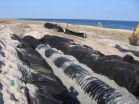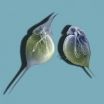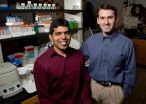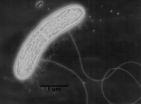(Press-News.org) Putnam Valley, NY. (Mar. 19 2013) – A team of researchers in Seoul, Korea have reported finding evidence that deer antlers - unique in that they regenerate annually - contain multipotent stem cells that could be useful for tissue regeneration in veterinary medicine.
The study appears as an early e-publication for the journal Cell Transplantation, and is now freely available on-line at http://www.ingentaconnect.com/content/cog/ct/pre-prints/ct0897seo.
"We successfully isolated and characterized antler tissue-derived multipotent stem cells and confirmed that the isolated cells are self-renewing and can differentiate into multiple lineages," said study co-author Dr. Kyung-Sun Kang of the College of Veterinary Medicine at Seoul National University. "Using optimized culture conditions, deer antler displayed vigorous cell proliferation."
Deer antler has been an issue in the news recently when professional athletes allegedly therapeutically used deer antler sprays, said to contain the insulin-like growth factor, IGF-1, to recover from injuries. The Korean research team did not investigate the potential for deer antler to be used in human therapies, but suggested that it could be used in veterinary medicine due to the impact of two important factors; the regenerative and the proliferative capabilities of the stem cells they isolated.
Stem cells, cells with the capability to differentiate into varieties of cells, have been isolated from a number of tissues, including bone marrow, fat tissues, umbilical cord blood, placenta and menstrual blood. Stem cell research in the last two decades has focused on both pluripotent stem cells, able to differentiate into all cell types of the body, and multipotent stem cells, able to differentiate into some but not all cell types, the latter of which has a longer history of study as they were identified earlier.
Researchers have sought to use transplanted stem cells for many regenerative purposes – from using them to regenerate neural cells following stroke or spinal cord injuries, to using stem cells to help regenerate failing or injured organs.
Deer antler is of interest, said the researchers, "because antlers are very peculiar organs in that they are lost and re-grown annually….a rare example of a completely regenerating organ in mammals."
According to the researchers, they subjected deer antler to differentiation assays for osteogenic (bone), adipogenic (fat) and chondrogenic (cartilage) lineages under culture conditions specific for each lineage to confirm the multi-lineage differentiation ability of antler multipotent stem cells. They concluded that deer antler tissue might be a "valuable source of stem cells" that could "be a potentially useful source of regenerative therapeutics in veterinary science."
The researchers noted that the development of deer-specific antibodies "is essential to confirm the identification of antler multipotent stem cells".
They specifically noted that injury to wild animals, including deer, might be treated using deer antler derived cells. They also pointed out that studies involving the use of horse stem cells have found clinical application of equine-derived stem cells.
"Deer-vehicle collision is frequent, inducing bone fracture," they wrote. "Antler multipotent stem cells could be used for therapeutic application for wild animal treatments and tissue engineering."
"This study highlights a novel source of stem cells for use in veterinary reparative therapies for wild animals" said Dr. Alison Willing, Professor at the Center of Excellence for Aging and Brain Repair, University of South Florida. "Future studies of these cells will allow their full potential as a therapy to be discerned."
###
Contact:
Dr. Kyung-Sun Kang
College of Veterinary Science
Seoul National University
Seoul 151-742, Korea
Email: kangpub@snu.ac.kr
Ph. 82-2-880-1241
Fax 82-2-876-7610
Citation: Seo, M-S.; Park, S-B.; Choi, S-W.; Kim, J-J.; Kim, H. S.; Kang, K. S. Isolation and characterization of antler derived multipotent stem cells. Cell Transplant. Appeared or available online: January 2, 2013.
The Coeditors-in-chief for CELL TRANSPLANTATION are at the Diabetes Research Institute, University of Miami Miller School of Medicine and Center for Neuropsychiatry, China Medical University Hospital, TaiChung, Taiwan. Contact, Camillo Ricordi, MD at ricordi@miami.edu or Shinn-Zong Lin, MD, PhD at shinnzong@yahoo.com.tw or David Eve, PhD at celltransplantation@gmail.com.
News release by Florida Science Communications.
A study published today in the journal Nature Genetics explores a new mechanism that may contribute to the development of several tumours, including Chronic Lymphocytic Leukaemia, a type of cancer that affects more than a thousand new patients in Spain each year.
This work, led by researchers Carlos López-Otín, from the University Institute of Oncology at the University of Oviedo; Elías Campo, from the Hospital Clínic/University of Barcelona; and María Blasco, the Director of the Spanish National Cancer Research Centre (CNIO), represents a significant milestone for the ...
When it rains, untreated stormwater can sweep pollutants into coastal waters, potentially endangering public health. Now researchers from North Carolina State University have developed low-cost filtration systems that are concealed beneath sand dunes and filter out most of the bacteria that can lead to beach closures.
"It was not economically feasible to use a tract of beachfront property to treat stormwater. Instead, we were able to devise a system that could be installed in an area that was not developable – underneath the dunes," says Dr. Michael Burchell, an assistant ...
Psychologists have traditionally characterized compulsive gambling as an "impulse control disorder," and treated it by addressing the patient's obsessive tendencies. But according to Prof. Pinhas Dannon of Tel Aviv University's Sackler Faculty of Medicine and the Beer Yaakov Mental Health Center, not all pathological gamblers fit the same profile.
Though gambling is typically associated with casino games, strategic sports betting is rapidly gaining in popularity — and that's a whole other ball game, Prof. Dannon explains. "Sports gamblers seem to believes themselves the ...
Daphnia is a genus of small, planktonic crustaceans, commonly called 'water fleas' because of their jumpy swimming style and their size (between 0.2 and 5 mm). They live in various aquatic environments, ranging from acidic swamps to freshwater lakes, ponds, streams and rivers. Species of the genus Daphnia play a key role in freshwater food webs: they consume algae and are themselves an important food item for small fish.
Daphnia lumholtzi is a small subtropical and tropical representative, known as an invader in North America. It has never been found in Europe in the ...
Boulder, Colo., USA – New Geology articles posted online ahead of print cover everything from cratering on Mars to leopard-like camouflage in trilobites. Locations studied include the Ries Impact Crater; Hydrate Ridge, Oregon; Stromboli volcano; northern Peru; the Bushveld Complex, South Africa; western and central New York state; the Sahara Desert; and the French Alps. Brief highlights follow:
1. Analogous cratering at the Ries Impact Crater, Germany, and on Mars;
2. A presentation of the first secure, high-resolution land-sea PSV-based sediment-core synchronization;
3. ...
A compact, self-contained sensor recorded and transmitted brain activity data wirelessly for more than a year in early stage animal tests, according to a study funded by the National Institutes of Health. In addition to allowing for more natural studies of brain activity in moving subjects, this implantable device represents a potential major step toward cord-free control of advanced prosthetics that move with the power of thought. The report is in the April 2013 issue of the Journal of Neural Engineering.
"For people who have sustained paralysis or limb amputation, rehabilitation ...
CHAMPAIGN, Ill. — Illinois chemists have used DNA to do a protein's job, creating opportunities for DNA to find work in more areas of biology, chemistry and medicine than ever before.
Led by Scott Silverman, a professor of chemistry at the University of Illinois at Urbana-Champaign, the researchers published their findings in the journal Proceedings of the National Academy of Sciences.
Ideally, researchers would like to be able to design and build new catalysts from scratch that can do exactly what they want. Many enzymes make small modifications to the building blocks ...
AMHERST, Mass. – When researchers at the University of Massachusetts Amherst led by microbiologist Derek Lovley discovered that the bacterium Geobacter sulfurreducens conducts electricity very effectively along metallic-like "microbial nanowires," they found physicists quite comfortable with the idea of such a novel biological electron transfer mechanism, but not biologists.
"For biologists, Geobacter's behavior represents a paradigm shift. It goes against all that we are taught about biological electron transfer, which usually involves electrons hopping from one molecule ...
Individuals infected by the hepatitis C virus (HCV) have nothing to fear from sex in a monogamous, heterosexual relationship. Transmission of HCV from an infected partner during sex is rare according to new research published in the March issue of Hepatology, a journal published by Wiley on behalf of the American Association for the Study of Liver Diseases (AASLD).
Experts estimate that HCV affects up to 4 million Americans, most of whom are sexually active. Medical evidence shows HCV is primarily transmitted by exposure to infectious blood, typically through intravenous ...
Government policies aimed at reducing greenhouse gas emissions from consumers need to be fairer for household income levels, says a University of Alberta researcher.
A U of A study published recently online in the journal Environment and Behaviour looks at the different sources of greenhouse gas emissions from consumers, based on their income levels. The wealthiest households in Alberta emit the most greenhouse gases, but too often, income disparity hasn't been factored in to current polices—such as the carbon flat tax that is levied to British Columbia residents.
Such ...




